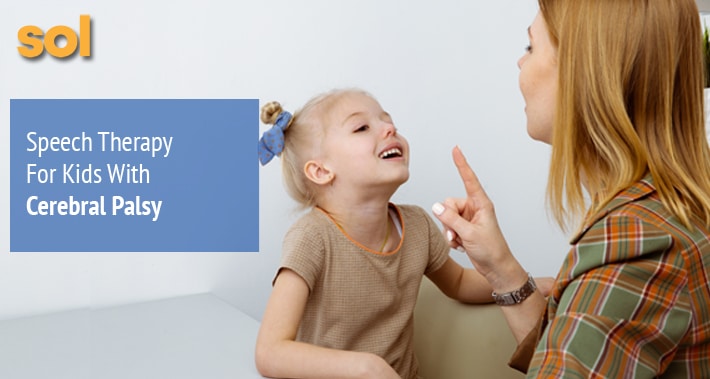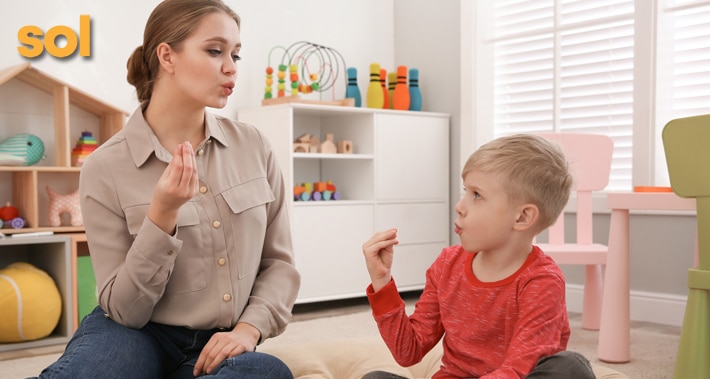
It’s common to see speech disorders affect people with cerebral palsy.
Cerebral palsy affects muscle movement and coordination.
This can cause children to have difficulty with controlling their face, throat, head, and neck muscles.
As a result, children might have trouble with speaking, chewing, and swallowing.
At Sol Speech and Language Therapy, we’re here to work with you and your child to develop their speech and language skills.
As a pediatric speech therapy clinic in Austin, we can help improve your child’s speech and communication and give them more independence.
Speech therapy can have a lot of benefits for children with cerebral palsy.
So let’s take a closer look at what cerebral palsy is and how speech and language therapy can help.
What Is Cerebral Palsy?
Cerebral palsy (CP) is a group of disorders that affect muscle movement, coordination, and the ability to hold your balance and posture.
“Cerebral” means having to do with the brain.
“Palsy” means weakness or problems with using muscles and body movement.
It’s the most common motor disability seen in childhood.
Cerebral palsy affects people differently and can become less or more limiting as children grow up and develop their motor skills.
There are actually four types of cerebral palsy, which has to do with which areas of the brain are affected.
Many have a combination of these and their effects on the body can change over the course of one’s life.
Let’s take a look at the different types of cerebral palsy.
Spastic Cerebral Palsy
Spastic cerebral palsy is the most common form of this movement disorder.
It causes muscle stiffness and exaggerated reflexes.
This can result in walking abnormalities, like unintentionally crossing your legs.
It’s possible to also have muscle weakness or paralysis.
This can affect your whole body or can be limited to just one side.
Children that have spastic cerebral palsy often struggle with slow and imprecise oral movements that take a lot of effort.
RELATED: Using Vegetables To Strengthen Your Child’s Oral Motor Skills
This may make their speech sound slurred and tight or hoarse.
Dyskinetic Cerebral Palsy
With dyskinetic cerebral palsy people have trouble controlling body movements.
It causes involuntary random movements in the limbs and extremities.
In some cases it may also affect their face and tongue.
This may lead to difficulty in controlling their breathing and their vocal folds, as well as your child having trouble with feeding, swallowing, and drooling.
Dyskinetic cerebral palsy can cause movements to be slow, rapid, or jerky.
As a result it can cause difficulty with walking, talking, and sitting.
Ataxic Cerebral Palsy
Ataxic cerebral palsy is less common than other types of this condition.
It involves involuntary muscle movements that may look disorganized and clumsy.
Problems with balance and coordination are often present in ataxic cerebral palsy.
This can cause issues with walking and fine motor skills.
“Scanning” speech, characterized by speaking in a breathy monotone voice, is also common in this form of cerebral palsy.
Those with ataxic cerebral palsy may have pauses and accelerations in their speech, as well as trouble swallowing.
Hypotonic Cerebral Palsy
Hypotonic cerebral palsy is characterized by reduced muscle tone and very relaxed muscles.
With this condition, your child’s limbs will move very easily and may appear floppy.
This is where the condition gets its unofficial name, “floppy baby syndrome.”
In infants this may cause them to have little control over their heads and have trouble breathing.
As they grow older it may cause struggles with sitting up straight due to their weakened muscles.
Other difficulties they can experience include poor reflexes, difficulty with speech, and walking abnormalities.
Mixed Cerebral Palsy
When a combination of symptoms from different types of cerebral palsy occurs, it’s called mixed cerebral palsy.
Most cases of mixed cerebral palsy cause people to experience symptoms of both spastic and dyskinetic cerebral palsy.
How To Tell If Your Child Has Cerebral Palsy?
Signs and symptoms of cerebral palsy differ from person to person and can be more mild or severe.
The effects of the condition may be more or less obvious as your child grows and begins to develop their motor skills.
These effects and symptoms also vary by which part of the brain was affected.
Some signs and symptoms to watch out for in your child include:
- Delays in motor skills (crawling, sitting up, rolling over)
- Muscle tone that’s too stiff or floppy
- Difficulty walking
- Spasticity – muscle stiffness and over the top reflexes
- Ataxia – lack of muscle coordination
- Involuntary movements
- Tremors
- Delays in speech development
- Difficulty with speaking
- Problems with swallowing and drooling
- Unbalanced use of one side of the body over the other
- Neurological issues
Most cases of cerebral palsy are congenital, meaning that children are born with the condition.
Signs and symptoms may not be evident for months or, in some cases, years.
Ultimately cerebral palsy is diagnosed by reviewing your child’s medical history and performing a physical exam with a detailed neurological exam.

How Does Cerebral Palsy Affect Speech?
Cerebral palsy can make it hard to control the muscles in your face, throat, neck, and head.
As a result this can lead to speech related issues.
Those that have their hearing affected by the condition may also have more difficulty comprehending spoken language.
RELATED: How Can Frequent Ear Infections Affect Speech Development?
As already mentioned, depending on which type of cerebral palsy your child has, it may affect their speech differently.
Children with spastic cerebral palsy often struggle with slow, imprecise oral movements and may have slurred or tight speech.
Dyskinetic cerebral palsy affects controlling body movements, sometimes in the face and tongue.
This leads to issues in controlling breathing and vocal chords.
In ataxic cerebral palsy muscle movements appear disorganized and clumsy.
This can affect speech with random pauses and accelerations and be accompanied by a breathy monotone voice.
Regardless of how cerebral palsy affects your child’s speech, speech therapy can help.
Can You Have Down Syndrome And Cerebral Palsy?
Yes you can, but it’s rare.
It’s important to note, though, that they aren’t the same disorder.
Both involve intellectual and physical disabilities, though.
As well, both may cause speech or language issues.
To find out more about Down syndrome, take a look at the article below.
RELATED: Speech Therapy For Kids With Down Syndrome
Can You Have Cerebral Palsy And Be Autistic?
Yes, that’s possible as well.
In fact, it’s more common for children with cerebral palsy to be autistic.
An estimated 7% of children with cerebral palsy are also autistic.
Compare that with an estimated 1% of the general population.
RELATED: Speech Therapy For Autistic Children
How Can Speech Therapy Help With Cerebral Palsy?
Speech therapy will be different for every child with cerebral palsy and will address their specific obstacles.
Treatment plans consist of exercises tailored for your child’s needs.
In some cases, assistive communication devices may be used to help your child express themselves.
Overall speech and language therapy your child can improve upon their ability to speak and communicate.
This works by strengthening the muscles they use for speech, increasing their oral motor skills, and helping them to improve their understanding of speech and language.
Because of these affected muscles, your child may also have problems with eating, chewing, and swallowing.
These difficulties may make it hard to maintain a healthy body weight and grow at a normal rate.
Speech therapy can provide benefits to these issues as well, making it easier for your child to eat and stay healthy.
Speech therapy can help with speech related issues such as:
- Articulation
- Stuttering
- Speech volume
- Language development
- Forming sounds and words
- Pronunciation
- Word comprehension
- Control over breathing
- Oral muscle coordination and strength
- Listening
RELATED: Using Mindfulness To Manage Stuttering
Through improving your child’s communication, speech therapy can also help with cognitive, social, and emotional development.
Speech therapy can improve your child’s overall quality of life in numerous aspects and prepare them for a more independent life.
Book Your Appointment With Sol Speech And Language Therapy Today
If your child has been diagnosed with cerebral palsy and has difficulty with speech and communication, we can help.
By intervening early we can work with your child to increase their ability to speak and communicate.
This can help them continue to develop their speech and language skills and independence.
This can be a scary time for both parents and children, but we are here so you don’t have to go through it alone.
We want to give your child the skills and tools they need to communicate effectively and aid in their development.
Book your appointment with Sol Speech And Language Therapy today.
6448 E Hwy 290 Suite E-108,
Austin, TX 78723
(512) 368-9488
» https://g.page/r/CfRfhOpEQm7BEAE
Sol Speech & Language Therapy
555 Round Rock W Dr E-221,
Round Rock, TX 78681
(512) 808-3953
» https://g.page/r/Cb5pwCTosSEfEBM
Sol Speech & Language Therapy offers personalized skilled intervention to those struggling with their speech and language skills. Services offered include screening, consultation, and comprehensive evaluation. We also provide one-on-one and/or group therapy for speech sound disorders, receptive/expressive language delay/disorder, stuttering/cluttering, accent reduction, and much more.